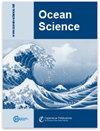基于系泊观测的海洋再分析对印度尼西亚通流输送的评估
IF 3.3
3区 地球科学
Q2 METEOROLOGY & ATMOSPHERIC SCIENCES
引用次数: 0
摘要
摘要热量和淡水从太平洋经印尼海输送到印度洋通常被称为印尼通流(ITF)。从季节内到年代际时间尺度上,ITF与大尺度现象之间的相互作用反映了其与全球海洋和气候系统的联系,表明需要对ITF区域进行监测。该区域的现场观测非常有价值,但它们在时间和空间上都不足以进行近实时监测。海洋再分析有可能成为近实时监测工具,并将时间序列向后延长,但迄今为止,还缺乏对该地区具有挑战性的水深测量的真实性进行全面的质量评估。我们的重点是通过哥白尼海洋服务(CMEMS)全球再分析集成产品(GREP)和更高分辨率的产品GLORYS12V1诊断的海洋运输,共六种再分析产品。通过对两个不同监测项目(即国际努沙捞分层和运输(INSTANT 2004-2006)和监测印度尼西亚通流(MITF 2006-2011和2013-2017)的现场观测结果进行验证,得出望加西海峡主要入流通道的总时间序列约为11.5年,而龙目岛海峡、Ombai海峡和帝汶通道的采样时间序列更短。结果表明,基于再分析的输运与观测在均值、季节周期和变率方面有一定的一致性,但仍存在一些不足。低分辨率产品不能准确地表示流的空间结构。他们还倾向于低估龙目岛和Ombai较窄海峡的综合净流量,这一点在GLORYS12V1中得到了改善。再分析往往低估了季节开尔文波对输送的影响,这导致了平均季节周期的误差。再分析输运的年际变化与观测值吻合较好,但次年际变化的不确定性要大得多。最后,应用海洋再分析提供的物理一致性和观测约束场,我们研究了垂直变化的压力梯度对ITF垂直结构的影响,以更好地理解明显的两层流动状态。本文章由计算机程序翻译,如有差异,请以英文原文为准。
Assessment of Indonesian Throughflow transports from ocean reanalyses with mooring-based observations
Abstract. The transport of heat and freshwater from the Pacific Ocean to the Indian Ocean via the Indonesian seas is commonly referred to as the Indonesian Throughflow (ITF). The interaction between the ITF and large-scale phenomena occurring from intraseasonal to decadal timescales reflects its connection to the global ocean and the climate system, indicating the need for monitoring the ITF region. In situ observations in this region are highly valuable, but they are temporally and spatially insufficient for near-real-time monitoring. Ocean reanalyses have the potential to serve as near-real-time monitoring tools and to extend time series backward in time, yet a comprehensive quality assessment of their realism in this region with challenging bathymetry has been lacking so far. We focus on oceanic transports diagnosed from the Copernicus Marine Service (CMEMS) Global Reanalysis Ensemble Product (GREP) and the higher-resolution product GLORYS12V1, totaling six reanalysis products. They are validated against in situ observations taken from two different monitoring programs, namely International Nusantara Stratification and Transport (INSTANT 2004–2006) and Monitoring the Indonesian Throughflow (MITF 2006–2011 and 2013–2017), resulting in a total time series of about 11.5 years in the major inflow passage of the Makassar Strait and shorter sampled time series in the Lombok Strait, the Ombai Strait, and the Timor Passage. Results show that there is reasonable agreement between reanalysis-based transports and observations in terms of means, seasonal cycles, and variability, although some shortcomings stand out. The lower-resolution products do not represent the spatial structure of the flow accurately. They also tend to underestimate the integrated net flow in the narrower straits of Lombok and Ombai, an aspect that is improved in GLORYS12V1. Reanalyses tend to underestimate the effect of seasonal Kelvin waves on the transports, which leads to errors in the mean seasonal cycle. Interannual variations of reanalyzed transports agree well with observations, but uncertainties are much larger on sub-annual variability. Finally, as an application of physically consistent and observationally constrained fields provided by ocean reanalyses, we study the impact of the vertically varying pressure gradient on the vertical structure of the ITF to better understand an apparent two-layer regime of the flow.
求助全文
通过发布文献求助,成功后即可免费获取论文全文。
去求助
来源期刊

Ocean Science
地学-海洋学
CiteScore
5.90
自引率
6.20%
发文量
78
审稿时长
6-12 weeks
期刊介绍:
Ocean Science (OS) is a not-for-profit international open-access scientific journal dedicated to the publication and discussion of research articles, short communications, and review papers on all aspects of ocean science: experimental, theoretical, and laboratory. The primary objective is to publish a very high-quality scientific journal with free Internet-based access for researchers and other interested people throughout the world.
Electronic submission of articles is used to keep publication costs to a minimum. The costs will be covered by a moderate per-page charge paid by the authors. The peer-review process also makes use of the Internet. It includes an 8-week online discussion period with the original submitted manuscript and all comments. If accepted, the final revised paper will be published online.
Ocean Science covers the following fields: ocean physics (i.e. ocean structure, circulation, tides, and internal waves); ocean chemistry; biological oceanography; air–sea interactions; ocean models – physical, chemical, biological, and biochemical; coastal and shelf edge processes; paleooceanography.
 求助内容:
求助内容: 应助结果提醒方式:
应助结果提醒方式:


